(完整)人教版小学四年级上英语学常用的单词及句子
- 格式:doc
- 大小:54.01 KB
- 文档页数:2
![[全]人教版小学英语四年级上册单元知识点](https://uimg.taocdn.com/3ffe57f6c850ad02df80411e.webp)
人教版小学英语四年级上册单元知识点第一单元Unit 1 My classroom一、核心词汇常见物体名称:classroom教室window窗户blackboard黑板light电灯picture图画door门teacher’s desk讲台computer计算机fan风扇wall 墙壁floor地板二、了解词汇1.其他:TV电视really(表示兴趣或惊讶)真的near距离近clean打扫help帮助2.常见的方位介词:in在……里面on在……上面under在……下面三、核心句型1.Wehaveanewclassroom.我们有间新教室。
解读:“Wehave…”意为“我们有……”。
拓展:此句中主语为第一人称复数形式,故谓语动词用have;当主语为第三人称单数形式时,谓语动词用has。
2.Let’sgoandsee!我们去看看吧!解读:let’s是letus的缩写形式,但let’s是包括听话者在内的“我们”,letus 不包括听话者。
3.—Whereisit?它在哪儿?—It’snearthewindow.就在窗户旁边。
解读:where用来询问物体或人的位置或方位。
回答时用in,on,under,near等方位介词。
4.What’sintheclassroom?教室里有什么?解读:这是询问某处有什么的句型,其中what’s是whatis的缩写形式。
拓展:想知道某物上面/下面/附近有什么,可以用“What’son/under/near+名词?”来提问。
5.Let me clean the windows.我来擦窗户。
解读:me是I的宾格形式。
letme后面要接动词原形。
四、了解句型1.Openthedoor.开门。
2.Turnonthelight.打开灯。
3.Closethewindow.关窗户。
4.Putupthepicture.张贴图画。
5.Cleantheblackboard.擦黑板。
6.Thedoorisorange.门是橘黄色的。


小学四年级英语知识点人教版小学四年级上册英语知识点This is my classroom. It's big. 这是我的教室。
它很大。
The door is green. The windows are yellow. 门是绿色的,窗户是黄色的。
Let's go and have a look. 让我们去看看吧!We have 6 new lights. 我们有六盏新灯。
Where's your seat? It's near the door.你的座位在哪里?在门附近。
Let's/ let me clean the board. 让我们/让我擦黑板。
Open the door打开门 Sweep the floor. 扫地。
Turn on the light. 打开灯。
Put up the picture. 挂图画。
Clean the board. 擦黑板。
Clean the window 擦窗户。
Window board light picture door floor puter teacher's desk wall fanI have a new schoolbag. 我有一个新书包。
What colour is it? It's black and white. 它是什么颜色的?它是黑白相间的。
My schoolbag is heavy. What's in it?我的书包很重。
里面有什么?Put your notebook in your bag. 把你的笔记本放进书包。
How many English books do you have? I have 6. 你有多少英语书?我有六本。
How many Chinese books can you see? I can see 20.你能看见多少本语文书?我能看见二十本。

2024人教版英语四年级上册一、单词部分。
1. Unit 1 My classroom.- 重点单词。
- classroom(教室),window(窗户),blackboard(黑板),light(灯),picture(图画),door(门),teacher's desk(讲台),computer(计算机),fan(风扇),wall(墙壁),floor(地板)。
- 记忆方法。
- 联想记忆:例如“classroom”,可以拆分成“class”(班级)和“room”(房间),就是班级所在的房间,也就是教室。
“window”可以想象窗户的形状,有很多长方形的玻璃。
对于“blackboard”,黑色(black)的板子(board)就是黑板。
2. Unit 2 My schoolbag.- 重点单词。
- schoolbag(书包),maths book(数学书),English book(英语书),Chinese book(语文书),storybook(故事书),candy(糖果),notebook(笔记本),toy(玩具),key(钥匙)。
- 记忆方法。
- 分类记忆:把书本类单词放在一起记忆,像“maths book”“English book”“Chinese book”“storybook”,它们都和书籍有关。
“candy”可以和它的美味口感联系起来,想象吃糖果的甜蜜感觉来记住这个单词。
3. Unit 3 My friends.- 重点单词。
- strong(强壮的),friendly(友好的),quiet(安静的),hair(头发),shoe(鞋子),glasses(眼镜),his(他的),her(她的)。
- 记忆方法。
- 对比记忆:“strong”和“weak”(虚弱的)对比,“quiet”和“noisy”(吵闹的)对比。
对于“hair”,可以摸摸自己的头发来加深印象,“shoe”就看看自己穿的鞋子。

四年级上册英语书词语表(人教版)一、词语表1.classroom /ˈklæsruːm/ 教室-解析:由class(班级)和room(房间)组成,是学生上课的场所。
-例句:This is our classroom.(这是我们的教室。
)2.window /ˈwɪndəʊ/ 窗户-解析:是建筑物中用于通风和采光的开口。
-例句:Look at the window.(看窗户。
)3.blackboard /ˈblækbɔːd/ 黑板-解析:通常为黑色的板子,用于教师书写教学内容。
-例句:The teacher is writing on the blackboard.(老师在黑板上写字。
)4.light /laɪt/ 电灯-解析:一种提供照明的设备。
-例句:Turn on the light.(打开灯。
)5.picture /ˈpɪktʃə(r)/ 图画-解析:用线条、色彩等描绘出的形象。
-例句:There is a beautiful picture on the wall.(墙上有一幅美丽的图画。
)6.door /dɔː(r)/ 门-解析:用于进出房间或建筑物的通道。
-例句:Open the door.(打开门。
)7.teacher's desk 讲台-解析:老师在教室里使用的桌子,通常用于放置教学用品。
-例句:The teacher is standing at the teacher's desk.(老师站在讲台上。
)puter /kəmˈpjuːtə(r)/ 计算机-解析:一种能够进行数据处理和存储的电子设备。
-例句:We use computers to learn.(我们用计算机学习。
)9.fan /fæn/ 风扇-解析:用于产生气流、带来凉爽的设备。
-例句:The fan is spinning.(风扇在旋转。
)10.wall /wɔːl/ 墙-解析:建筑物中起分隔和支撑作用的部分。

人教版4上英语重点人教版4上英语的重点内容如下:1. Unit 1: Nice to meet you!- Greetings and introductions- Vocabulary: hobbies, likes and dislikes- Sentence patterns: "What's your name?" "My name is..."- Grammar: present simple tense with frequency adverbs2. Unit 2: How do you go to school?- Vocabulary: transportation methods, places in a city- Sentence patterns: "How do you go to...?" "I go by..."- Grammar: prepositions of place (in, on, at), object pronouns (me, him, her, us), plural nouns3. Unit 3: Where are you from?- Vocabulary: countries, nationalities, languages- Sentence patterns: "Where are you from?" "I'm from..."- Grammar: verb "to be" (am, is, are), possessive pronouns (my, his, her, our)4. Unit 4: I have a pen pal.- Vocabulary: household items, pen pals, daily routines- Sentence patterns: "Do you have a...?" "Yes, I do. / No, I don't."- Grammar: present simple tense, plural nouns, third person singular5. Unit 5: Our classroom rules.- Vocabulary: school subjects, classroom objects, rules- Sentence patterns: "What do you have on...?" "We have..."- Grammar: questions with "What", imperatives, imperative sentences with "Let's"6. Unit 6: What's this in English?- Vocabulary: classroom objects, stationery, food- Sentence patterns: "What's this in English?" "It's a..."- Grammar: singular and plural nouns, possessive case (John's book)以上是人教版4上英语的重点内容,希望能对你有所帮助!。
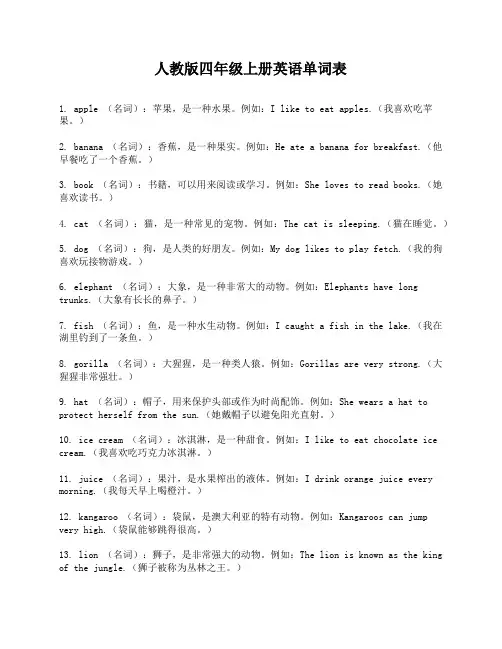
人教版四年级上册英语单词表1. apple (名词):苹果,是一种水果。
例如:I like to eat apples.(我喜欢吃苹果。
)2. banana (名词):香蕉,是一种果实。
例如:He ate a banana for breakfast.(他早餐吃了一个香蕉。
)3. book (名词):书籍,可以用来阅读或学习。
例如:She loves to read books.(她喜欢读书。
)4. cat (名词):猫,是一种常见的宠物。
例如:The cat is sleeping.(猫在睡觉。
)5. dog (名词):狗,是人类的好朋友。
例如:My dog likes to play fetch.(我的狗喜欢玩接物游戏。
)6. elephant (名词):大象,是一种非常大的动物。
例如:Elephants have long trunks.(大象有长长的鼻子。
)7. fish (名词):鱼,是一种水生动物。
例如:I caught a fish in the lake.(我在湖里钓到了一条鱼。
)8. gorilla (名词):大猩猩,是一种类人猿。
例如:Gorillas are very strong.(大猩猩非常强壮。
)9. hat (名词):帽子,用来保护头部或作为时尚配饰。
例如:She wears a hat to protect herself from the sun.(她戴帽子以避免阳光直射。
)10. ice cream (名词):冰淇淋,是一种甜食。
例如:I like to eat chocolate ice cream.(我喜欢吃巧克力冰淇淋。
)11. juice (名词):果汁,是水果榨出的液体。
例如:I drink orange juice every morning.(我每天早上喝橙汁。
)12. kangaroo (名词):袋鼠,是澳大利亚的特有动物。
例如:Kangaroos can jump very high.(袋鼠能够跳得很高。
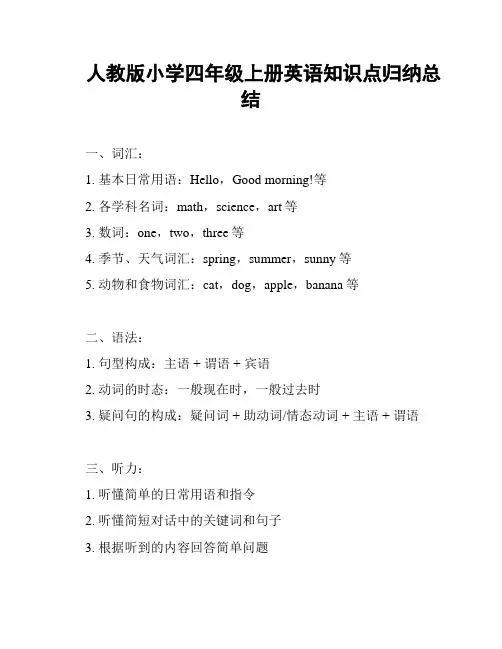
人教版小学四年级上册英语知识点归纳总
结
一、词汇:
1. 基本日常用语:Hello,Good morning!等
2. 各学科名词:math,science,art等
3. 数词:one,two,three等
4. 季节、天气词汇:spring,summer,sunny等
5. 动物和食物词汇:cat,dog,apple,banana等
二、语法:
1. 句型构成:主语 + 谓语 + 宾语
2. 动词的时态:一般现在时,一般过去时
3. 疑问句的构成:疑问词 + 助动词/情态动词 + 主语 + 谓语
三、听力:
1. 听懂简单的日常用语和指令
2. 听懂简短对话中的关键词和句子
3. 根据听到的内容回答简单问题
四、口语:
1. 能用简短的句子进行日常交流
2. 能用简单的词汇和句子进行自我介绍
3. 能用简单的语句表达自己的感受和喜好
五、阅读:
1. 能读懂简单的单词、短句和段落
2. 能根据图片或简短句子回答问题
3. 能阅读简单的故事或对话并理解基本内容
六、写作:
1. 能用简单的语句写出自己的名字、年龄和喜好
2. 能用简单的句子描述描绘短文中的内容
3. 能写出简短对话或简单的日记、便条等
以上是人教版小学四年级上册英语的知识点归纳总结,希望对您有所帮助。
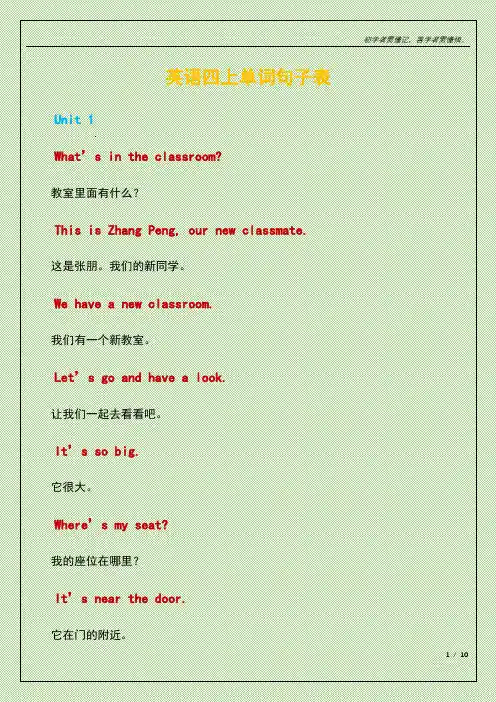
英语四上单词句子表Unit 1What’s in the classroom?教室里面有什么?This is Zhang Peng, our new classmate.这是张朋。
我们的新同学。
We have a new classroom.我们有一个新教室。
Let’s go and have a look.让我们一起去看看吧。
It’s so big.它很大。
Where’s my seat?我的座位在哪里?It’s near the door.它在门的附近。
The wall is white.墙是白色的。
Let’s clean the classroom.让我们一起打扫教室吧。
Good idea.好主意。
Let me clean the window.让我来擦窗户。
Look at the picture.看那幅图画。
Good job!做得好!Unit 2How many books do you have? I have 6. 你有几本书?我有6本。
I have a new schoolbag.我有一个新书包。
What colour is it?它是什么颜色的。
It’s black and white.它是黑色和白色的。
I have many books.我有许多书。
May I have a look?我可以看看吗?Sure. Here you are.当然可以。
给你。
How many English books can you see? 你可以看见多少本英语书?I can see …. Sorry, too many.我可以看到……对不起,太多了。
My schoolbag is heavy. 我的书包太重了。
What’s in it?它里面有什么?Unit 3My friend is strong.我的朋友很强壮。
He has short hair.他有短头发。
Who is he?他是谁?A Chinese friend?一个中国朋友?What’s his name?他的名字叫什么?His name is Zhang Peng. 他的名字叫张朋。
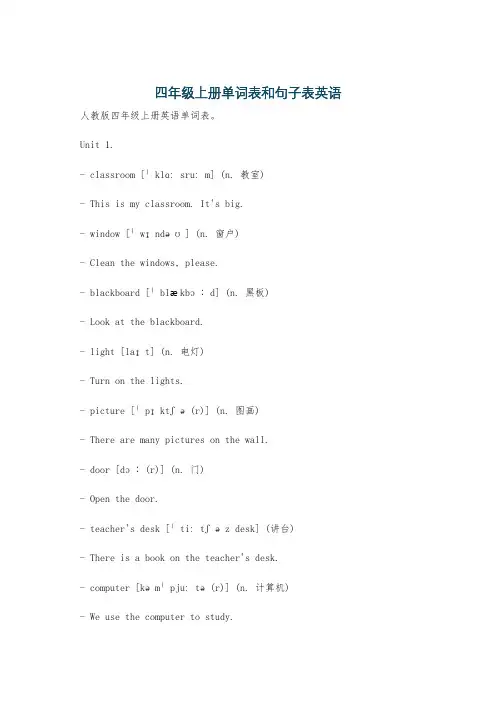
四年级上册单词表和句子表英语人教版四年级上册英语单词表。
Unit 1.- classroom [ˈklɑːsruːm] (n. 教室)- This is my classroom. It's big.- window [ˈwɪndəʊ] (n. 窗户)- Clean the windows, please.- blackboard [ˈblækbɔːd] (n. 黑板)- Look at the blackboard.- light [laɪt] (n. 电灯)- Turn on the lights.- picture [ˈpɪktʃə(r)] (n. 图画)- There are many pictures on the wall.- door [dɔː(r)] (n. 门)- Open the door.- teacher's desk [ˈtiːtʃəz desk] (讲台)- There is a book on the teacher's desk.- computer [kəmˈpjuːtə(r)] (n. 计算机)- We use the computer to study.- fan [fæn] (n. 风扇)- The fan is on the ceiling.- wall [wɔːl] (n. 墙壁)- There is a map on the wall.- floor [flɔː(r)] (n. 地板)- Sweep the floor.Unit 2.- schoolbag [ˈskuːlbæɡ] (n. 书包)- I have a new schoolbag.- maths book [mæθs bʊk] (n. 数学书)- My maths book is in my schoolbag.- English book [ˈɪŋɡlɪʃ bʊk] (n. 英语书)- Read your English book.- Chinese book [ˌtʃaɪˈniːz bʊk] (n. 汉语书) - Where is your Chinese book?- storybook [ˈstɔːribʊk] (n. 故事书)- I like reading storybooks.- candy [ˈkændi] (n. 糖果)- Don't eat too much candy.- notebook [ˈnəʊtbʊk] (n. 笔记本)- Write in your notebook.- toy [tɔɪ] (n. 玩具)- My favourite toy is a doll.- key [kiː] (n. 钥匙)- I lost my key.- lost [lɒst] (v. (lose的过去式)丢失) - I lost my pen.- so much [səʊ mʌtʃ] (非常地)- Thanks so much.- cute [kjuːt] (adj. 可爱的)- The cat is very cute.Unit 3.- strong [strɒŋ] (adj. 强壮的)- My father is very strong.- friendly [ˈfrendli] (adj. 友好的)- He is a friendly boy.- quiet [ˈkwaɪət] (adj. 安静的)- Keep quiet in the library.- hair [heə(r)] (n. 头发)- Her hair is long.- shoe [ʃuː] (n. 鞋)- Put on your shoes.- glasses [ˈɡlɑːsɪz] (n. 眼镜)- He wears glasses.- his [hɪz] (pron. 他的)- This is his book.- or [ɔː(r)] (conj. 或者)- Is it blue or green?- right [raɪt] (adj. 正确的; 对的)- Your answer is right.- hat [hæt] (n. 帽子)- Put on your hat.Unit 4.- bedroom [ˈbedruːm] (n. 卧室)- This is my bedroom.- living room [ˈlɪvɪŋ ruːm] (n. 起居室; 客厅) - We watch TV in the living room.- study [ˈstʌdi] (n. 书房)- I read books in the study.- kitchen [ˈkɪtʃɪn] (n. 厨房)- My mother cooks in the kitchen.- bathroom [ˈbɑːθruːm] (n. 浴室; 洗手间) - Wash your hands in the bathroom.- bed [bed] (n. 床)- There is a big bed in my bedroom.- phone [fəʊn] (n. 电话)- Answer the phone.- table [ˈteɪbl] (n. 桌子)- There are some apples on the table.- sofa [ˈsəʊfə] (n. 沙发)- Sit on the sofa.- fridge [frɪdʒ] (n. 冰箱)- There is some milk in the fridge.Unit 5.- beef [biːf] (n. 牛肉)- I like beef.- chicken [ˈtʃɪkɪn] (n. 鸡肉)- Do you like chicken?- noodles [ˈnuːdlz] (n. 面条)- I often eat noodles for breakfast.- soup [suːp] (n. 汤)- Have some soup.- vegetable [ˈvedʒtəbl] (n. 蔬菜)- We should eat more vegetables.- chopsticks [ˈtʃɒpstɪks] (n. 筷子)- Use chopsticks to eat.- bowl [bəʊl] (n. 碗)- There is some rice in the bowl.- fork [fɔːk] (n. 叉子)- Use a fork to eat the salad.- knife [naɪf] (n. 小刀)- Cut the bread with a knife.- spoon [spuːn] (n. 勺子)- Use a spoon to drink soup.Unit 6.- parents [ˈpeərənts] (n. 父母)- My parents are very kind.- cousin [ˈkʌzn] (n. 同辈表亲(或堂亲))- My cousin is a student.- uncle [ˈʌŋkl] (n. 舅父; 叔父; 伯父; 姑父; 姨父)- My uncle is a doctor.- aunt [ɑːnt] (n. 姑母; 姨母)- My aunt is a teacher.- baby brother [ˈbeɪbi ˈbrʌðə(r)] (婴儿小弟弟)- My baby brother is very cute.- doctor [ˈdɒktə(r)] (n. 医生)- I want to be a doctor.- cook [kʊk] (n. 厨师)- My father is a cook.- driver [ˈdraɪvə(r)] (n. 司机)- His father is a driver.- farmer [ˈfɑːmə(r)] (n. 农民)- The farmer works hard.- nurse [nɜːs] (n. 护士)- My sister is a nurse.人教版四年级上册英语句子表。
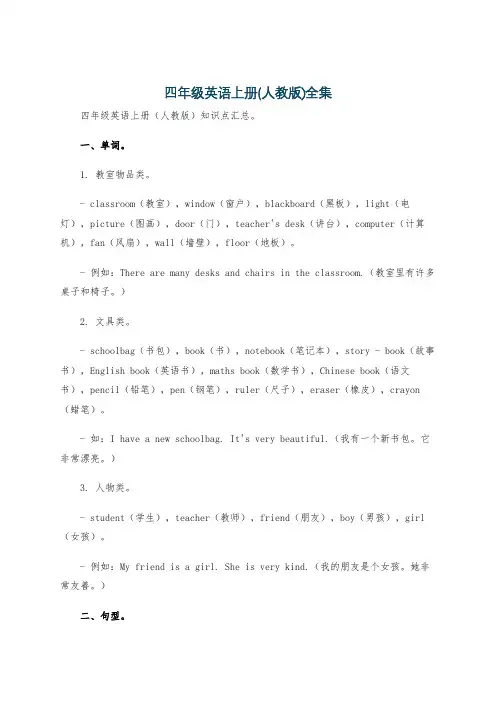
四年级英语上册(人教版)全集四年级英语上册(人教版)知识点汇总。
一、单词。
1. 教室物品类。
- classroom(教室),window(窗户),blackboard(黑板),light(电灯),picture(图画),door(门),teacher's desk(讲台),computer(计算机),fan(风扇),wall(墙壁),floor(地板)。
- 例如:There are many desks and chairs in the classroom.(教室里有许多桌子和椅子。
)2. 文具类。
- schoolbag(书包),book(书),notebook(笔记本),story - book(故事书),English book(英语书),maths book(数学书),Chinese book(语文书),pencil(铅笔),pen(钢笔),ruler(尺子),eraser(橡皮),crayon (蜡笔)。
- 如:I have a new schoolbag. It's very beautiful.(我有一个新书包。
它非常漂亮。
)3. 人物类。
- student(学生),teacher(教师),friend(朋友),boy(男孩),girl (女孩)。
- 例如:My friend is a girl. She is very kind.(我的朋友是个女孩。
她非常友善。
)二、句型。
1. 询问物品位置。
- Where's + 物品? It's + 方位介词短语.- 例如:Where's my book? It's on the desk.(我的书在哪里?它在桌子上。
)- 方位介词短语有:in(在……里面),on(在……上面),under(在……下面),near(在……附近)等。
2. 描述人物。
- He/She is + 形容词.- 如:He is tall and strong.(他又高又壮。
人教版小学英语四年级知识点整理HEN system office room 【HEN16H-HENS2AHENS8Q8-HENH1688】小学四年级英语知识点整理上册Unit 1 School Subjects (After school)一.重点词汇:( Vocabulary)英语语文音乐美术. 数学二.Sounds and words:米饭老鼠脸跳舞科学cream冰淇淋三.重点句子:(Target)1. Do you like math? Yes, I do. 你喜欢数学吗?是的,我喜欢。
2. Do you like science? No, I don’t. 你喜欢科学吗?不,我不喜欢。
3. What subjects do you like, Gogo? 果果,你喜欢什么科目?I like art and music. 我喜欢美术和音乐。
4、What’s that? 那是什么?It’s my science book. 那是我的科学书。
5. I like science, math, English, and .我喜欢科学,数学、英语和体育。
6. What do you like, Gogo? 果果,你喜欢什么什么科目?I like art, too.我也喜欢美术。
四、重点句型1.问某人喜欢哪个科目,可以用句型:What subjects do/does____ like?如:1)What subjects do you like? I like math and music.2)What subjects does he/she like? He/She likes math and music.2.问某人是否喜欢某个科目,可以问: Do/Does ___like___? 如:1)Do you like math? Yes, I do./ No, I don’t.2)Does he like math? Yes, he does./No, he doesn’t.3.一起做某事,应该说: Let’ s_______.( let’s 后面加动词原形)Unit2 School Activities (Gogo is skating )一. 重点词汇:(Vocabulary)painting绘画 read阅读 3. sleep/sleeping 睡觉singing唱歌 writing写字 6. study/studying学习7. play/playing 玩 running跑步二.Sounds and words:1. painting绘画2. reading阅读3. sleeping 睡觉4. singing唱歌5. fishing钓鱼6. swimming游泳三.重点句子: (Target)1 .What are you doing? 你正在干什么?I’m writing.我正在写字。
新人教版四年级英语上册单元词汇句子Unit 1 教室物品1.教室2.窗户3.黑板4.电灯5.图画6.门7.讲台8.计算机9.风扇10.墙壁11.地板12.(表示兴趣或惊讶)真的13.距离近14.电视15.打扫16.帮助Unit 2 文具1.书包2.数学书3.英语书4.语文书5.故事书6.糖果7.笔记本8.玩具9.钥匙10.哇;呀11.丢失(lose的过去式形式)12.非常地13.可爱的Unit 3 描述人物1.强壮的2.友好的3.安静的4.头发5.鞋6.眼镜7.他的8.或者9.正确的;对的10.(常指带檐的)帽子11.她的Unit 4 房间及其陈设1.卧室2.客厅;起居室3.书房4.厨房5.浴室;洗手间6.床7.电话8.桌子9.长沙发10.冰箱11.找到12.他(她、它)们Unit 5 食物和餐具1.牛肉2.鸡肉3.面条4.汤5.蔬菜6.筷子7.碗8.餐叉9.刀10.勺11.中午或晚上吃的)正餐12.准备好13.为(自己)取用14.给;递15.试;尝试Unit 6 家庭成员和职业1.父母2.同辈表亲(或堂亲)3.舅父;叔父;伯父;姑父;姨夫4.姑母;姨母5.婴儿小弟弟6.医生7.厨师8.司机9.农民10.护士11.人们12.但是13.小的14.小狗15.足球运动员16.工作17.篮球我们有间新教室。
我们去看看吧!它在哪儿?就在窗户旁边。
我们打扫教室吧!我来擦窗户。
你的书包里有什么?一本英语书,一本数学书,三本故事书什么颜色的?是蓝白色的。
他叫什么名字?他叫张鹏。
他又高又壮。
他是谁?他戴眼镜,穿篮色鞋子。
她在客厅里吗?不,她不在。
钥匙在哪儿?它们在桌子上吗?不,不在,它们在门上。
晚餐吃什么?你想吃什么?我想要汤和面包。
随便吃吧。
你想要刀叉吗?不了,谢谢。
我会用筷子。
你家有几口人,陈杰?三口人。
我家有六口人。
这是你叔叔吗?是的,他是位足球运动员。
你婶婶做什么工作?她是位护士。
人教PEP四年级上册单词及常用表达词汇表Unit11. classroom [ˈklɑːsruːm]n. 教室2. window [ˈwɪndəʊ] n. 窗户3. blackboard [ˈblækbɔːd] n. 黑板4. light [laɪt] n. 电灯5. picture [ˈpɪktʃə(r)] n. 图画6. door [dɔː(r)] n. 门7. teacher’s desk 讲台8. computer [kəmˈpjuːtə(r)] n. 计算机9. fan [fæn] n. 风扇10. wall [wɔːl]n. 墙壁11. floor[flɔː(r)]n. 地板12. really [ˈriəli] adv. 真的13. near [nɪə(r)] prep. 距离近14. TV 电视15. clean [kliːn]v. 打扫16. help [help] v. 帮助Unit21. schoolbag [ˈskuːl bæg] n. 书包2. maths book 数学书3. English book 英语书4. Chinese book 语文书5. storybook [ˈstɔːribʊk] n. 故事书6. candy [ˈkændi]n. 糖果7. notebook [ˈnəʊtbʊk] n. 笔记本8. toy [tɔɪ] n. 玩具9. key [kiː]n. 钥匙10. wow [waʊ] int. 呀;哇(惊叹声)11. lost [lɒst] v. (lose的过去式形式)丢失12. so much 非常地13. cute [kjuːt]adj. 可爱的Unit31. strong [strɒŋ]adj. 强壮的2. friendly [ˈfrendli]adj. 友好的3. quiet [ˈkwaɪət] adj. 安静的4. hair [heə(r)] n. 头发5. shoe [ʃuː]n. 鞋6. glasses [ˈglɑːsɪz]n. 眼镜7. his [hɪz] pron. 他的8. or [ɔː(r)]conj. 也不,也没有9. right [raɪt] adj. 正确的;对的10. hat [hæt] n.(常指带檐的)帽子11. her [hɜ:(r)] pron. 她的Unit41. bedroom [ˈbedruːm]n. 卧室2. living room起居室;客厅3. study [ˈstʌdi] n. 书房4. kitchen [ˈkɪtʃɪn] n. 厨房5. bathroom [ˈbɑːθruːm]n. 浴室;洗手间6. bed [bed] n. 床7. phone [fəʊn] n. 电话8. table [ˈteɪbl] n. 桌子9. sofa [ˈsəʊfə] n. 长沙发10. fridge [frɪdʒ] n. 冰箱11. find [faɪnd] v. 找到12. them [ðəm] pro n. 他们;她们;它们Unit51. beef [biːf]n. 牛肉2. chicken [ˈtʃɪkɪn] n. 鸡肉3. noodles [ˈnuːdlz]n. 面条4. soup [suːp]n. 汤5. vegetable [ˈvedʒtəbl] n. 蔬菜6. chopsticks ['tʃɒpstɪks] n. 筷子7. bowl [bəʊl] n. 碗8. fork [fɔːk] n. 餐叉9. knife [naɪf] n. 刀10. spoon [spuːn]n. 勺11. dinner [ˈdɪnə(r)] n. 正餐12. ready [ˈredi]adj. 准备好13. help yourself 为(自己)取用;请自便14. pass [pɑːs]v. 给;递15. try [traɪ] v.& n. 试;尝试Unit61. parents [ˈpeərənts] n. 父母2. cousin [ˈkʌzn] n. 堂兄弟;表兄弟;堂姐妹;表姐妹3. uncle [ˈʌŋkl]n. 叔叔;伯父;舅父;姑父,姨父4. aunt [ɑːnt]n. 阿姨;姨母,姑妈;舅妈;婶娘5. baby brother 婴儿小弟弟6. doctor [ˈdɒktə(r)] n. 医生7. cook [kʊk] n. 厨师8. driver [ˈdraɪvə(r)] n. 司机9. farmer [ˈfɑːmə(r)] n. 农民10. nurse [nɜːs] n. 护士11. people [ˈpiːpl]n. 人,人们12. but [bʌt] conj. 但是13. little [ˈlɪtl] adj. 小的14. puppy ['pʌpɪ] n. 小狗15. football player 足球运动员16. job [dʒɒb] n. 工作17. basketball [ˈbɑːskɪtbɔːl]n. 篮球常用表达法:Unit1We have a new classroom. 我们有间新教室。
(人教版)小学英语四年级上册单词句子汇总Unit 1 (四上)一.单词部分:中国:China 美国:America 英格兰:England 新加坡:Singapore 加拿大:Canada 朋友:friend哪里:where 从:from 来自:be from 我们:we 男孩:boy 女孩:girl 司机:driver 漂亮的:beautiful农民:farmer 教师:teacher 医生doctor 酷:cool 护士:nurse 邮递员postman 男警察:policeman女警察:policewoman 记者:reporter 电视记者:TV reporter 游戏:game 玩:play 我们的:our 小心的,仔细的:careful 是谁:who is =who’s 他是:he’s=he is她是:she’s=she is 我们是:we’re=we are二.句子部分:1.又一次见到你很高兴。
Nice to see you again.2.你来自哪里? Where are you from?3.我来自美国。
I’m from America.4.我来自中国北京。
I’m from Beijing , China.5.我们是好朋友。
We’re good friends.6.这是我的新朋友,Jim。
This is my new friend,Jim.7.欢迎到我们家来。
Welcome to our home.8.这个男孩是谁? Who’s this boy?9.他是我的哥哥。
He’s my brother.10.这个女孩是谁?Who’s this girl?11.他是我的妹妹。
She’s my sister.12.让我们玩个游戏吧。
Let’s play a game.13.他很酷。
He’s cool.14.你爸爸是干什么的? What does your father do ?15.他是一名教师。
人教版四年级英语上册单词表Unit 1 My Classroomclassroom /ˈklɑːsruːm/ 教室window /ˈwɪndəʊ/ 窗户blackboard /ˈblækbɔːd/ 黑板light /laɪt/ 电灯picture /ˈpɪktʃə(r)/ 图画door /dɔː(r)/ 门teacher's desk 讲台computer /kəmˈpjuːtə(r)/ 计算机fan /fæn/ 风扇wall /wɔːl/ 墙壁floor /flɔː(r)/ 地板really /ˈriːəli/ 真的near /nɪə(r)/ 在……旁边TV /ˌtiːˈviː/ 电视clean /kliːn/ 打扫help /help/ 帮助Unit 2 My Schoolbagschoolbag /ˈskuːlbæɡ/ 书包maths book 数学书English book 英语书Chinese book 语文书storybook /ˈstɔːribʊk/ 故事书candy /ˈkændi/ 糖果notebook /ˈnəʊtbʊk/ 笔记本toy /tɔɪ/ 玩具key /kiː/ 钥匙wow /waʊ/ 哇;呀lost /lɒst/ 丢失so much 非常地cute /kjuːt/ 可爱的Unit 3 My Friendsstrong /strɒŋ/ 强壮的friendly /ˈfrendli/ 友好的quiet /ˈkwaɪət/ 安静的hair /heə(r)/ 头发shoe /ʃuː/ 鞋glasses /ˈɡlɑːsɪz/ 眼镜his /hɪz/ 他的or /ɔː(r)/ 或者right /raɪt/ 正确的;对的hat /hæt/ 帽子her /hɜː(r)/ 她的Unit 4 My Homebedroom /ˈbedruːm/ 卧室living room 客厅;起居室study /ˈstʌdi/ 书房kitchen /ˈkɪtʃɪn/ 厨房bathroom /ˈbɑːθruːm/ 浴室;洗手间bed /bed/ 床phone /fəʊn/ 电话table /ˈteɪbl/ 桌子sofa /ˈsəʊfə/ 长沙发fridge /frɪdʒ/ 冰箱find /faɪnd/ 找到them /ðem/(they 的宾格)他(她、它)们Unit 5 Dinner's Readybeef /biːf/ 牛肉chicken /ˈtʃɪkɪn/ 鸡肉noodles /ˈnuːdlz/ 面条soup /suːp/ 汤vegetable /ˈvedʒtəbl/ 蔬菜chopsticks /ˈtʃɒpstɪks/ 筷子bowl /bəʊl/ 碗fork /fɔːk/ 餐叉knife /naɪf/ 刀spoon /spuːn/ 勺子dinner /ˈdɪnə(r)/ 正餐;晚餐ready /ˈredi/ 准备好help yourself 为(自己)取用pass /pɑːs/ 给;递Unit 6 Meet My Family!parents /ˈpeərənts/ 父母cousin /ˈkʌzn/ 同辈表亲(或堂亲)uncle /ˈʌŋkl/ 舅父;叔父;伯父;姑父;姨夫aunt /ænt/ 姑母;姨母baby brother 婴儿小弟弟doctor /ˈdɒktə(r)/ 医生cook /kʊk/ 厨师driver /ˈdraɪvə(r)/ 司机farmer /ˈfɑːmə(r)/ 农民nurse /nɜːs/ 护士people /ˈpiːpl/ 人们but /bət/ 但是little /ˈlɪtl/ 小的puppy /ˈpʌpi/ 小狗football player 足球运动员。
英语四年级上册单词句子表四年级上册的英语单词和句子表通常包括一些基础的词汇和句子,帮助学生建立起英语基础。
下面是一些可能出现在四年级上册英语课本中的单词和句子:1. 单词,apple, book, cat, dog, elephant, fish, girl, happy, ice cream, jump.句子,I have an apple. This is a book. The cat is black. The dog is big. The elephant is in the zoo. The fish swims in the water. The girl is playing. I am happy. I like ice cream. I can jump high.2. 单词,bike, kite, lion, monkey, nest, orange, pen, queen, rabbit, sun.句子,I ride a bike. The kite flies high. The lion is roaring. The monkey is climbing the tree. The bird has a nest. I like orange juice. This is my pen. The queen is kind. The rabbit is cute. The sun is shining.3. 单词,train, umbrella, violin, watermelon, xylophone, yo-yo, zebra.句子,I see a train. I need an umbrella. I play the violin. I like watermelon. I can play the xylophone. I have a yo-yo. The zebra has stripes.这些单词和句子涵盖了一些常见的名词、动词和形容词,以及一些日常生活中常见的场景和活动。
四年级上册学过的单词(按词性分类)疑问代词:用于特殊疑问句,表示疑问。
1.what 什么例:What is in your schoolbag?你的书包里有什么?一、疑问代词What’s in it ? 它里面有什么?2.where哪里例:Where is my key?我的钥匙在哪里Where are the shoes ? 鞋子在哪里?3.who 谁例:Who is your good friend?谁是你的好朋友?Who is this boy ? 这个男孩是谁?人称代词作主语用于句子的前面,主语表示句子的描述的是“谁”或是“什么”,是谓语的陈述对象。
(谁是什么/谁怎么样)第一人称:主语I 我例:I have a new friend.我有一个新朋友。
主语we 我们例:We have a new classroom.我们有一个新教室。
二、人称代词第二人称:主语you 你;你们第三人人称:主语he 他He has short hair. 他有短头发。
(主语)主语she 她例:She has big eyes. 她有大眼睛。
主语it 它例:It has long tail. 它有长尾巴。
It is a monkey.它是猴子.主语they 他(它、她)们例:They are in the kitchen .。
它们在厨房。
人称代词:宾语是动作的承担着或承受者(是动词的对象或内容).第一人称:宾语me 我例:let me clean the window. 让我来打扫窗户。
Let me help you . 我来帮助你。
(宾语)第二人称:宾语you 你;你们例:How are you? I am fine. 你好吗?我很好。
Nice to meet you to . 见到你我很高兴。
第三人称:宾语him 他her 她例:Look at her. 看她(形容词性物主代词)表示“谁的”,后面可以加名词。
第一人称:my 我的例:This is my pencil . 这是我的铅笔。
our 我们的例:Who is the man ? He is our maths teacher.那个男士是谁?他是我们的数学老师。
第二人称:your你的;你们的例:What is your name?你的名字是什么?第三人称:his 他的例:His schoolbag is blue. 他的书包是蓝色的。
her她的例:Her hair is long. 她的头发长。
its 它的例:Its airs are big. 它的耳朵很大。
their 他(她它)们的注:you 既表示“你”,又表示“你们”。
her 既表示宾语“她”又表示物主代词“她的”四、be动词:有三个am/ is/ are 表示“是”am是用于I am……我是……is是用于第三人称单数: she is…… he is……例:She is my maths teacher.她是我的数学老师。
He is tall and strong.他又高又强壮。
It is a cat.它是一只猫。
The door is green. 门是绿色的。
My schoolbag is heavy .我的书包很重。
My mother is a worker .我的妈妈是一名工人。
are 是用于第二人称或名词的复数。
例:They are my classmate.他们是我的同学。
Are you Mike? 你是迈克吗? The walls are green.墙是绿色的。
Her shoes are brown.她的鞋子是棕色的。
His glasses are blue. 他的眼镜是蓝色的。
五、常用的动词和对应的第三人称单数。
have →has (有) do →does(放在主语前构成疑问句)例:I have a new pen . 我有一支新钢笔。
We have many candies.我们有许多糖果。
He has short brown hair.他有短的棕色的头发。
My dog has big eyes. 我的小狗有一双大眼睛。
Her friends have same toys.她的朋友有一些玩具。
My family has six people. 我的家有六口人。
六、the 【定冠词】意义相当于“这(些)”“那些”,通常不被翻译出来。
this这;这个—— these这些(this的复数)that 那;那个——those那些(that的复数)here(在)这里;到这里there在那里;往那里 there +be 结构表示“有”的意思。
七、名词所有格。
表示所有关系、所属关系、动作的执行者、动作的承受者等意义时。
在名词后面加’s ,表示“谁的”例如:teacher’s desk 讲桌 mother’s job 妈妈的工作my sister ’s name 我的妹妹的名字 Sarah’s father. 萨拉的爸爸He is she is it is I am I would what is where is is not who is do not they are八、缩写形式和全写形式。
Let us= Let ’s (让我们) I am= I ’m(我是)she is= she ’s (她是)he is= he ’s (他是)it is= it ’s (它是)I would= I ’d 我想要who is = who ’s (谁是)what is= what ’s (什么是)is not= isn’t (他她它)不是do not = don’t 不where is= where ’s哪里are not = aren’t (他们)不是they are = they’re(它她)他们是通常以be,have(do)动词开头的句子,只需回答yes或no。
(肯定或否定)例:Is it near the door? Yes ,it is .No it isn’t. 它在门的旁边吗?Is she in the kitchen? Yes ,she is .No she isn’t. 她在厨房吗?Is this a bathroom? Yes ,it is .No it isn’t. 这个是洗手间吗?Is that a living room? Yes ,it is .No it isn’t.那个是客厅吗?Is this your uncle? Yes ,he is . he is a football player.他是你的叔叔吗?是的,他是。
他是一名足球运动员。
Are they in the study? Yes ,they are .No they aren’t.它们在书房吗?Are they near the phone? Yes ,they are .No they aren’t.它们在电话的旁边吗?Are you from Canada? Yes ,I am .No I am not. 你来自加拿大吗?Are they on the table? Yes ,they are .No they aren’t. 它们在桌子上吗?Do you like maths ? Yes ,I do .No I don’t. 你喜欢数学吗?Do you see my glasses. Yes ,I do .No I don’t. 你看见我的眼镜了吗?Can you spell it? Yes ,I can .No I can’t. 你能拼写出它吗?Can I have a knife and fork please? Yes . 我可以用刀和餐叉吗?Would 的用法:表示要求、邀请、希望或询问,尤其后了接like ,love 等动词时,表示“愿”。
例:Would you like same beef ? Yes, thank you.你想吃点牛肉吗?是的,谢谢你。
Would you like some noodles ? Yes ,please ./ No ,thanks.你想吃点面条吗?是,可以。
/ 不、谢谢Would you like some vegetables for dinner? 你想晚餐吃些蔬菜吗?十、特殊疑问句。
以疑问代词who ,what ,where ,how 等开头的句子;不能用yes 或no 来回答。
Who is your maths teacher? 谁是你的数学老师?Who is he ? He is Zhang Peng他是谁?他是张鹏。
What colour is your schoolbag?你的书包是什么颜色?What would you like? I’d like same beef,你喜欢吃什么?我喜欢吃牛肉。
What would you like for dinner? 晚餐你想要什么?What ’s your father ’s job? 你的爸爸做什么工作?What ’s in your bed room ? 你的卧室里有什么?What ’s in your desk?你的桌子上有什么?Where ’s your pencil box?你的文具盒里有什么/Where are my crayons? 我的蜡笔在哪里?How many people are there in your family? 你家有几口人?How many storybooks do you have ? 你有多少本书?。